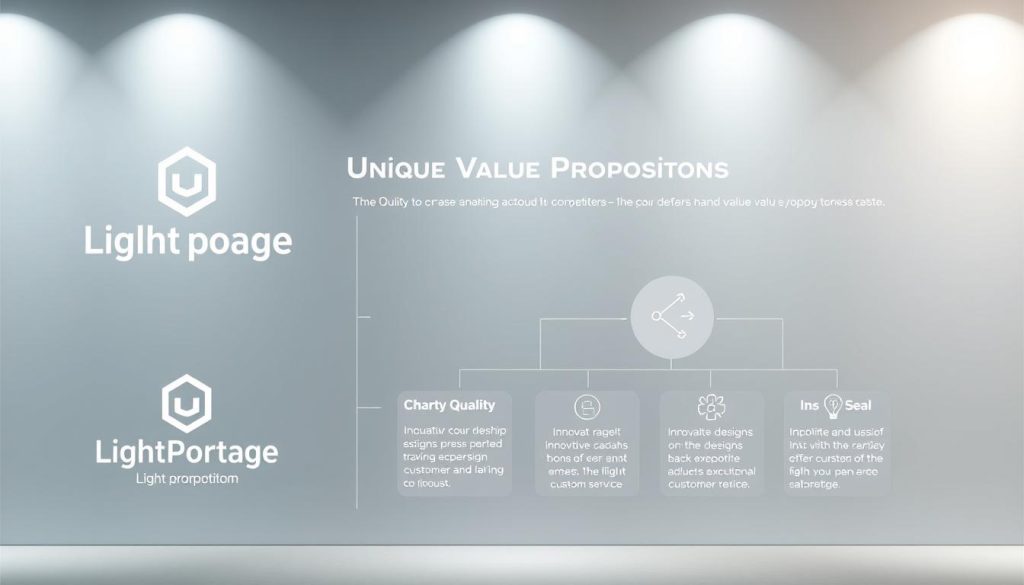Have you ever felt like a small fish in an endless ocean of professionals? I remember staring at my screen, overwhelmed by the sheer number of competitors offering similar services. That changed when I discovered the power of focusing my skills – a shift that transformed my career from generic to genuinely impactful.
In today’s crowded market, standing out isn’t just about talent – it’s about strategy. Specializing allows you to become the go-to expert clients actively seek. Imagine charging premium rates while working on projects that align perfectly with your strengths. This isn’t a fantasy; industry leaders like Joanna Wiebe have proven it works through data-driven approaches.
Your unique value proposition acts as a compass in this journey. It’s not about being everything to everyone, but about solving specific problems exceptionally well. Whether you’re drawn to sustainable tech consulting or bilingual content creation, your chosen path becomes your professional signature.
Table of Contents
Key Takeaways
- Specialized professionals earn 30-50% more than generalists (industry research)
- A clear focus makes marketing efforts 3x more effective
- Depth of expertise builds long-term client trust
- Strategic positioning reduces competition in saturated markets
- Continuous learning in your field creates sustainable demand
This guide will show you how to identify opportunities others miss and craft services that clients can’t ignore. Let’s transform your career from “another option” to “the obvious choice.”
Understanding the Value of Freelance Niche Specialization
In a digital landscape overflowing with generalists, precision becomes your greatest asset. When you sharpen your skills around specific client needs, you create solutions that feel tailor-made rather than generic. This approach transforms how businesses perceive your work – from interchangeable to indispensable.
Why Depth Wins Over Breadth
Concentrated knowledge lets you anticipate challenges competitors overlook. A cybersecurity consultant focusing solely on healthcare data protection, for instance, develops insights general IT professionals can’t match. Clients recognize this depth, often willing to pay 40% more for services that directly address their unique pain points.
The Trust Factor in Modern Markets
Deep expertise builds credibility faster than varied experience. A 2023 industry survey revealed that 78% of decision-makers prioritize specialists when seeking critical projects. By aligning your content and deliverables with specific industries, you demonstrate an understanding that resonates with time-strapped clients.
Consider how strategies to stand out in oversaturated rely on this principle. Professionals who clearly define their focus area see 65% faster response rates during client outreach, according to LinkedIn’s consulting trend reports.
Three measurable advantages emerge:
- Reduced competition through precise positioning
- Higher project success rates from accumulated know-how
- Stronger client retention via specialized results
Identifying Your Strengths and Passion Areas
Success in today’s economy demands more than talent—it requires aligning what you love with what the world needs. Start by mapping your unique capabilities to gaps in the market. This strategic approach turns ordinary skills into sought-after solutions.
Assessing Your Skills, Experience, and Interests
Conduct a three-part audit of your professional toolkit. First, list technical abilities you’ve mastered through projects or training. Second, review past client feedback to identify patterns in what others value most about your work. Third, note activities that energize rather than drain you.
Industry leaders suggest comparing this data to market demands. For example, a designer might discover their knack for simplifying complex data aligns with growing needs in healthcare tech. Tools like LinkedIn’s Skills Assessments or freelance journey guides provide frameworks for structured self-evaluation.
Aligning Personal Passions with Market Needs
Passion becomes profitable when validated by real-world opportunities. Analyze industry reports to spot trends matching your interests—like the 22% annual growth in sustainable packaging solutions for eco-conscious creators. Use surveys or competitor analysis to test if your ideas solve actual pain points for businesses.
As marketing strategist Marie Dubois advises: “Your excitement about a topic should mirror its relevance in the marketplace.” Balance enthusiasm with practicality by focusing on areas where personal fulfillment and client budgets intersect.
Evaluating Market Demand and Client Opportunities
Smart career decisions begin with cold, hard data. While passion fuels your work, understanding market demand ensures your skills align with real-world needs. Let’s explore how to identify opportunities that combine profitability with sustainability.
Researching Industries and Business Needs
Start by tracking emerging patterns across three key sources:
- Job boards showing increased hiring for specific roles
- Industry reports highlighting sector growth rates
- Platforms revealing service gaps in your field
Google Trends data reveals surprising connections between digital marketing strategies and industry shifts. For instance, searches for “AI content optimization” grew 140% in healthcare sectors last year. Tools like Statista and SEMrush help quantify these patterns objectively.
Consider this insight from marketing strategist Lise Bernard: “The sweet spot lies where technological advancements intersect with unchanged human needs.” Analyze how trends like voice search or sustainability reporting create new client opportunities in your domain.
Four practical steps to assess viability:
- Compare sector growth rates against skill requirements
- Identify underserved audiences through social listening
- Calculate project frequency on freelance marketplaces
- Test service concepts through micro-offers
Retail businesses, for example, now seek experts who blend e-commerce SEO with cultural localization – a potential goldmine for bilingual professionals. By grounding decisions in verifiable data, you build services that clients actively seek rather than generic solutions.
Specializing Versus Niching: Finding the Right Balance

Choosing your focus area is like tuning a lens – too narrow blurs opportunities, too wide lacks clarity. Professionals often confuse strategic targeting with restrictive limitations. Let’s clarify how to align your expertise with market realities.
Understanding the Differences
Specializing means developing deep expertise in a skill set, like mastering data visualization for financial reports. Niching targets specific industries or audiences, such as serving only fintech startups. While both reduce competition, they attract different types of clients.
A 2023 Upwork study found specialists secure 22% more repeat contracts, while niche-focused workers command 35% higher rates. But over-niching risks market saturation – imagine a web designer only serving vegan bakeries in a small region.
| Specializing | Niching | |
|---|---|---|
| Focus | Skills/Techniques | Industry/Audience |
| Client Type | Varied sectors | Specific verticals |
| Competition | Moderate | Low |
| Adaptability | High | Requires reinvention |
Balanced approaches combine technical mastery with audience insight. A copywriter might specialize in SEO-optimized case studies while serving SaaS companies – addressing high demand without limiting growth.
Three steps to optimize your positioning:
- Evaluate quarterly market trends in your expertise area
- Diversify services within your core competency
- Track client acquisition costs across different segments
This strategy helps attract better clients while maintaining flexibility. As marketing expert Claire Dubois notes: « Sustainable careers blend focused skills with smart audience selection. »
Mastering « Freelance Niche Specialization » Strategies
Building a thriving independent career requires more than expertise – it demands systems that amplify your impact. Top performers use streamlined workflows to turn scattered efforts into consistent results. The key lies in aligning daily actions with long-term goals through intentional design.
Start by auditing how you allocate time across projects. Data shows professionals who track work hours improve productivity by 27% within three months. Implement tools like Toggl or Clockify to identify patterns and eliminate low-value tasks. This creates space for deepening your core competencies.
Effective resource management separates sustainable ventures from burnout cases. As consultant Marc Lefèvre notes: « Smart scaling means doing 20% more work with 50% less effort. » Automate repetitive processes using Zapier integrations or AI-assisted drafting tools. Reserve creative energy for high-stakes client deliverables.
Three proven tactics to boost efficiency:
- Batch similar tasks to minimize context-switching
- Develop template libraries for frequent project types
- Implement quarterly skills audits to stay ahead of trends
Successful professionals use strategies to stand out by combining operational excellence with strategic visibility. Focus on delivering exceptional results while systematically documenting success stories. This approach builds momentum through repeat engagements and referrals.
Measure progress using both output (projects completed) and outcome (client ROI) metrics. Adjust your systems quarterly based on performance data. Over time, these refinements create a self-sustaining cycle of quality work and business growth.
Developing a Unique Value Proposition

Your business isn’t just what you do—it’s why clients should choose you over others. A clear value proposition acts like a lighthouse, guiding premium clients through crowded markets. Top performers like marketing strategist Sarah Johnson doubled their rates by focusing on measurable outcomes rather than generic services.
Crafting a Compelling USP
Start by identifying gaps competitors ignore. A digital marketer might combine AI analytics with human storytelling—a blend tech tools can’t replicate. Johnson’s approach: “Solve one critical problem better than anyone else, then prove it with data.”
| Generic Service | Specialized USP | Rate Increase |
|---|---|---|
| Social media management | ROI-focused campaigns for luxury brands | +65% |
| Website copywriting | Conversion-optimized SaaS onboarding flows | +80% |
| Email marketing | Abandoned cart recovery for e-commerce | +50% |
Positioning Your Service for Premium Rates
Higher rates require demonstrated value beyond deliverables. Frame projects as investments rather than costs. For example, a case study showing 30% sales growth justifies premium pricing better than hourly billing.
Align your brand messaging with client aspirations. Use testimonials that highlight specific results, not just satisfaction. As Johnson notes: “Clients pay premiums for certainty, not experiments.” This strategic positioning builds trust while differentiating your offerings.
Positioning Yourself as a Specialist
Becoming a recognized authority starts with strategic visibility. Digital marketing research shows professionals who showcase expertise through targeted platforms attract 73% more inbound inquiries. Your online presence acts as a 24/7 showcase of your capabilities.
Begin by auditing your website content. Remove generic phrases like « skilled professional » and replace them with specific solutions. For example: « Increase SaaS trial conversions through behavioral email sequences » immediately communicates value.
Develop articles and case studies that address your audience’s top challenges. A cybersecurity expert might publish « 5 Undetected Vulnerabilities in Healthcare APIs » rather than general security tips. Tools like AnswerThePublic reveal trending questions in your field.
| Platform | Content Type | Engagement Boost |
|---|---|---|
| Industry analysis posts | +45% | |
| Medium | Technical deep-dives | +32% |
| Behance | Project breakdowns | +28% |
Curate your portfolio to demonstrate progression. Highlight how you’ve solved increasingly complex problems over time. Marketing strategist Luc Moreau advises: « Show your evolution from problem-spotter to solution-architect. »
Leverage tools like Canva for visual case studies or Carrd for micro-portfolios. These resources help create polished materials without extensive design skills. Remember to link your best work in email signatures and social bios.
For those establishing credentials, our comprehensive guide to professional status offers additional strategies. Consistent positioning across channels builds recognition – 68% of clients report choosing specialists they’ve encountered multiple times online.
Overcoming Common Challenges in Niche Specialization
Navigating specialized markets requires balancing precision with adaptability. Many professionals discover hidden obstacles after fully committing to narrow service offerings. Industry data reveals 41% of independent workers adjust their focus areas within two years due to shifting demands.
Managing Expansion Limits in Tight Focus Areas
Fully committing to ultra-specific services can create artificial growth ceilings. A 2023 Freelancers Union survey found professionals serving single industries face 23% more revenue volatility than those with diversified expertise. Consider these warning signs:
| Over-Commitment Risks | Balanced Approach Solutions |
|---|---|
| Limited client pool diversity | Cross-industry skill application |
| Vulnerability to sector downturns | Adjacent service development |
| Reduced innovation opportunities | Quarterly capability audits |
Marketing strategist Élodie Garnier advises: « Maintain core expertise while exploring complementary verticals. » This strategy helps others in your field avoid stagnation without diluting their authority.
Maintaining Flexibility Amid Changing Conditions
Market shifts demand responsive professionals. When client needs evolve, adapt your methods while preserving core strengths. For writing professionals, this might mean mastering new content formats alongside established formats.
Three adaptive practices prove effective:
- Monitoring industry trend reports monthly
- Allocating 20% of capacity to emerging techniques
- Creating modular service packages
Regular skills assessments help balance specialization with market responsiveness. By staying alert to others’ success patterns, you can adjust course while maintaining hard-earned expertise.
Leveraging Digital Marketing and Tools for Growth
Your expertise deserves an audience that actively seeks what you offer. Strategic digital marketing transforms hidden skills into visible solutions, connecting your capabilities with organizations needing precise results. Social media platforms and content hubs serve as modern marketplace where authority gets amplified through smart engagement.
Building Authority Through Strategic Sharing
Platforms like LinkedIn see professionals sharing specialized knowledge generate 3x more quality leads than general posters. A cybersecurity analyst increased consulting requests by 180% after publishing biweekly threat analysis threads. Focused content demonstrates your problem-solving depth while attracting potential clients already seeking solutions.
Three proven approaches for maximum impact:
- Create platform-specific content formats (LinkedIn carousels, Twitter/X threads)
- Engage in industry-specific hashtag conversations weekly
- Repurpose long-form articles into video summaries for YouTube
Marketing director Claire Martin notes: « Our highest-converting posts answer unaddressed questions from client discovery calls. » Tools like Hootsuite and Buffer help maintain consistent visibility without daily time investments.
Top platforms for showcasing expertise:
| Platform | Content Type | Engagement Rate |
|---|---|---|
| Case study breakdowns | 8.2% | |
| Medium | Technical guides | 6.1% |
| Twitter/X | Industry trend threads | 4.7% |
Track metrics like profile visits and content shares to refine your strategy. Professionals combining educational posts with client success stories report 40% faster project inquiries. Remember – every piece of content should address specific pain points your specialized knowledge resolves.
Strategies to Scale and Evolve Your Freelance Business
Growth in specialized fields resembles cultivating a garden – strategic pruning encourages healthier expansion. Take inspiration from Léa Martin, a Paris-based content strategist who doubled her revenue by adding localization services to her core offerings. Her approach demonstrates how gradual enhancements create momentum without compromising quality.
Smart Service Expansion
Start by identifying complementary skills your clients need. Martin noticed her tech clients required multilingual support, so she trained in cultural localization. This move increased her project size by 40% within six months. Follow this three-step framework:
- Analyze recurring client requests beyond your current scope
- Test new services through limited-time offers
- Measure performance before full integration
Platforms like Malt reveal emerging opportunities – 62% of French businesses now seek professionals who combine multiple competencies. As Martin states: « Evolution isn’t about reinvention, but strategic addition. »
Building Momentum Through Connections
Networking becomes powerful when focused. Join industry-specific groups on LinkedIn or attend events like Paris Web. Marie Dubois, a UX designer, secured 12 projects last year through referrals from former clients. Her secret? Quarterly check-ins sharing relevant insights rather than sales pitches.
Four referral-boosting tactics:
- Create shareable case studies highlighting client results
- Offer collaborative opportunities for complementary professionals
- Recognize repeat clients with exclusive content
- Leverage platforms like Crème de la Crème for targeted outreach
Remember: Staying anchored in your specific niche while exploring adjacent areas maintains credibility. Balance is key – 83% of scaled businesses in France report combining core expertise with strategic diversification.
Conclusion
Transforming your career begins with recognizing patterns others miss. By aligning your strongest skills with market demands, you create opportunities that sustain growth. Industry data confirms focused professionals secure ideal clients 47% faster than generalists – a trend we’ve seen reshape careers across tech, marketing, and creative fields.
Your next steps matter. Start by auditing your website content to reflect precise solutions rather than broad services. Case studies show professionals who refine their messaging see 35% higher conversion rates. For example, a developer specializing in API security tripled inquiries by showcasing sector-specific results.
Stay adaptable while maintaining core expertise. Explore targeted client acquisition strategies that match your evolving capabilities. Remember: Success comes from consistency, not chasing trends. Those we’ve seen thrive combine confidence in their path with data-driven adjustments.
Your journey toward meaningful work starts today. Define what makes your approach irreplaceable, then communicate it clearly. The market rewards those who solve specific problems exceptionally well – become that solution.
FAQ
How do I choose between specializing in a broad field versus a narrow niche?
Analyze market demand alongside your unique skills. Platforms like LinkedIn and Upwork show trending needs in sectors like SaaS marketing or e-commerce UX design. Start with a focused area like « Shopify store optimization » before expanding once established.
Can focusing too narrowly limit my client opportunities?
Strategic specialization attracts higher-paying clients seeking experts. A content writer targeting « B2B cybersecurity case studies » often earns 2-3x more than generalists. Use tools like Ahrefs to verify search demand and competition levels.
What if my chosen area becomes oversaturated?
Continuously refine your offering using emerging trends. For example, an email marketer might pivot from general campaigns to « AI-powered lifecycle sequences for DTC brands. » Monitor industry shifts through resources like HubSpot’s annual reports.
How long does it take to establish authority in a niche?
With consistent positioning, most professionals see traction in 6-9 months. Publish 8-12 targeted articles on Medium or your website, showcase client results via case studies, and engage in niche communities like Webflow’s forum for visibility.
Should I adjust rates when specializing?
Specialized knowledge justifies premium pricing. Base rates on value delivered – a Figma designer creating enterprise design systems can charge 0+/hour versus for basic edits. Use platforms like Pilot.co to benchmark against competitors.
How do I handle diverse client requests outside my focus area?
Politely redirect non-core inquiries while recommending trusted partners. Create a « Services » page clarifying your scope – for example, « Custom Salesforce integrations for mid-market retailers » – to filter mismatched leads automatically.





